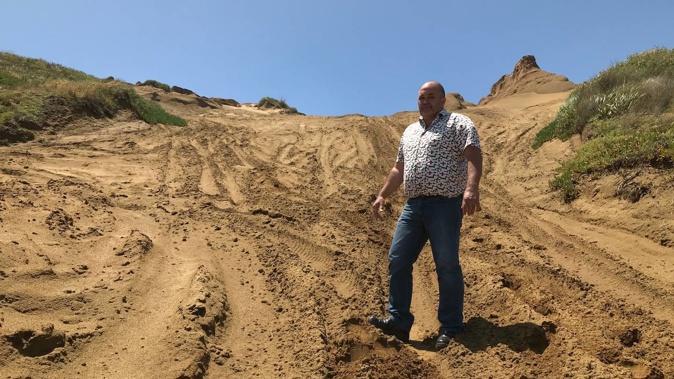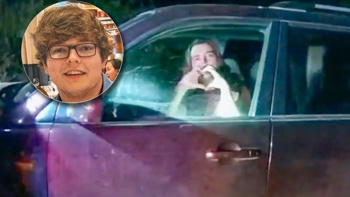
text by Susan Botting, Local Democracy Reporter
A toxic cocktail of speed and too many vehicles is threatening lives – and the environment – on New Zealand's longest driveable beach.
That's the grim warning from a Kaipara leader who says the problem is worsening.
Tauranga 13-year-old Daisy Fernandez died after being struck by an unregistered motorbike on Ripiro's Glinks Gully on December 31 2007 - one of several deaths on the beach.
"It's only a matter of time until someone else is killed on Ripiro Beach," David Wills, Kaipara District Councillor said.
The west coast's Ripiro Beach runs for 107km from Maunganui Bluff, south to Pouto Point settlement at the tip of Pouto Peninsula on Kaipara Harbour's northern entrance. It's the longest driveable beach in New Zealand.
/cloudfront-ap-southeast-2.images.arcpublishing.com/nzme/NNP2P44QGGQWALD7UDXRSHEUH4.jpg?width=1300&height=260&mode=max)
Hundreds of off-roaders, other four-wheel drives, cars and quad bikes and motorbikes are increasingly flocking to the beach – along with every-growing numbers of people.
The beach is classified as a road. It has a 100km/h speed limit outside small pockets of 30km/h zones around settlements - including Manganui Bluff, Omamari, Baylys Beach, Glinks Gully and Pouto Point.
"We have been discovered as a destination for off-roading," Graeme Ramsey, 25-year Baylys Bach resident and former Kaipara mayor and Northland Regional Council deputy chairman said.
There were also cars doing drifting at the beach and vehicles of all sorts hooning about.
Ramsey said the problem wasn't being adequately addressed by regulations. Road rules weren't being enforced and stronger policing was needed.
"Drivers are exceeding the speed limit which is posing increased safety and environmental risk," Ramsey said.
The police were asked for comment but did not respond.
/cloudfront-ap-southeast-2.images.arcpublishing.com/nzme/ZXK7PQJAXBMPN32GKGDETLX3PM.jpg?width=753&height=565&mode=max)
Sand dune damage where a four-wheel drive's gone no higher on Ripiro beach dune. Photo / Susan Botting
Big numbers of people were expected this summer as a result of New Zealanders not being able to travel overseas.
"There's increasing confrontation between vehicle users and other beach users," Wills said.
"I have been threatened with physical violence when asking a four-wheel-drive vehicle driving dangerously close to us to slow down as my wife and I walked along the beach."
Wills is calling for a stronger effort to manage Ripiro Beach through more combined work between those with shared responsibility for its management. He's spearheading a new push from KDC, as one of the organisations legally responsible for official beach management, towards this happening between his council, Northland Regional Council, the Department of Conservation and police.
He said off-roaders from south of Tai Tokerau were increasingly coming to Ripiro Beach in the wake of stronger restrictions at Muriwai on Auckland's west coast.
The vehicles on the beach situation's got so bad on Muriwai that - in a first - it's being closed over the summer use peak from Wedesday until January 10 for the first time.
Permits to drive the beach were being introduced in 2015 but fewer than half those doing so have been using them.
At least eight people have been killed on Muriwai through four wheel drive accidents. Police patrols, covert cameras and photo identification for drivers are among tools used to manage growing use demand
Internationally-important sand dune systems at Pouto Peninsula's southern tip are among the areas hardest hit by Ripiro Beach off-roaders.
Pouto's the nearest west coast wilderness four-wheel drive opportunity north of Auckland.
/cloudfront-ap-southeast-2.images.arcpublishing.com/nzme/ZP4UQLGPITCGR65DI2HVZR2YZY.jpg?width=714&height=535&mode=max)
Shags dry their wings in the brief moments between four wheel drives on Maunganui Bluff at the northern end of Ripiro Beach Photo / Susan Botting
Wills said off roaders were driving up the 85m sand cliffs to the 1884 Pouto lighthouse and then often through surrounding dunes.
This brought archaeological and cultural concerns. There were a number of Māori artefacts in this area. These were at risk of being damaged.
Six hundred hectares of dunes at the peninsula's tip are among New Zealand's last large-scale remaining pristine dune areas - ranked as of extremely high national and international importance.
Wills said they supported threatened plant and animal species including nationally and regionally important populations of northern New Zealand dotterel and significant grey duck populations.
Jimmy Kiddie, president of Silverdale Rodney Off Road Club said Aucklanders were increasingly going to Pouto and driving north along Ripiro Beach.
"There's basically no wilderness left in Auckland. It's basically all houses now," Kiddie said.
Kiddie agreed four-wheel drive and other off-road vehicles were creating problems at Pouto and further north.
But he said it was non-club four-wheel drivers creating problems.
"There are a lot of people with four-wheel drives that don't belong to clubs. They're speeding and doing doughnuts. They've got a four-wheel drive and think they can go anywhere," Kiddie said.
He's been four-wheel driving at Pouto and further north for more than 25 years.
"There are definitely more vehicles now," he said.
Kiddie said four-wheel drive clubs were keen to look after the wilderness to ensure its future availability.
He wouldn't like to see Pouto closed to four-wheel drives because of the actions of a few.
Wills said major damage to sand dunes and cliffs along the beach's length was a big problem.
/cloudfront-ap-southeast-2.images.arcpublishing.com/nzme/BDHQKWM44XY5SKRQMXTOSJ6I6I.jpg?width=613&height=460&mode=max)
Mahuta Gap sand dune damage. Photo / Susan Botting
Off-roaders were using winches to pull out fences and obstacles put in by landowners to protect their land, he said.
Vehicles were wrecking fragile west coast dune ecosystems along the entire beach by driving over the dunes.
"Vehicles can destroy the plants that help keep the sand dunes strong, killing them with just one drive by," Wills said.
Vehicle tracks were clearly visible in at least half a dozen places along a 10km stretch between Ripiro's Mahuta Gap and Baylys Beach when Northland's Local Democracy Reporter visited.
Wills said persistent driving on dunes had already killed vegetation in some places. This was creating sand blows as a result, where dunes no longer stabilised by vegetation started to move inland engulfing adjacent farm paddocks as they spilled onto ever-increasing areas across grass.
Healthy dunes provide a constantly replenishing, critical barrier between land and sea. A small area of damaged dune can become a major area of sand blow migrating inland, within two years growing to the size of about 1.5 rugby fields.
Ramsey said vehicles, including cars, were driving over toheroa beds, crushing the iconic New Zealand shellfish which lived in the mid-tide zone where many travelled.
"I've seen a person doing doughnuts on top of a toheroa bed.
"We're worried about our toheroa beds. Toheroa are a taonga for the nation," Ramsey said.
Take your Radio, Podcasts and Music with you









